Introduction
Fire has been a significant part of southeastern forests for thousands of years, ignited by lightning strikes and by humans. In contemporary times, intentional fires (hereafter: prescribed fires) are used to achieve three common objectives: reduction of wildfire risk, site preparation, and competition reduction in both silvicultural operations and habitat improvement (e.g., to maintain fire-dependent species). Prescribed fire is considered an effective method to achieve these goals (Wade et al. 1989), but sometimes it is not possible to use this tool. For example, heavy fuel loads, smoke management concerns, limited weather days that fit a site’s fire prescription, the unavailability of equipment and staff,and a site’s proximity to the wildland-urban interface may preclude the use of prescribed fire to manage forested land.
Fortunately, there are alternative treatment options (hereafter: surrogates) that land managers can consider. Although none of these surrogates will produce the same suite of benefits prescribed fire delivers, as among them nutrient cycling, pyric-stimulated seeding (as seen in wiregrass), and fuel load removal, these surrogates can mimic some of prescribed fire’s benefits, and surrogate treatments are almost always better than applying no treatments. This publication provides an overview for landowners and land managers who want to understand surrogate treatments and the economic and ecological tradeoffs associated with each treatment.
Mechanical Treatments as Fire Surrogates
The goals of mechanical surrogates are to alter stand structure and reduce fire hazard by rearranging fuels. Examples include roller/drum chopping, mowing/mulching, timber harvesting, and hand-felling operations. Many of these incorporate the use of heavy wheeled or tracked machinery (e.g., tractors, skid steers, dozers, feller-bunchers, skidders). Compared to the per-acre cost of prescribed burning, mechanical treatments are more costly. However, these surrogates tend to produce more consistent, predictable results at a significantly lower liability. Although mechanical treatments change fuel arrangement in the treatment area, they do not necessarily reduce overall fuel loading. This can be troublesome in cases where trees and woody plants are pushed from a vertical to a horizontal position. These compact fuels reduce the risk of extreme fire behavior, but should a fire occur after treatment, the piles can smolder and cause smoke-management concerns. To minimize the spread of invasive species, managers must invest time, effort, and resources to ensure that all equipment they bring to a property to perform a mechanical treatment is scrupulously cleaned. Finally, hydrologic site conditions may make mechanical treatments untenable. Generally, the drier the site during mechanical treatments, the lower the chance for site damage. Mechanical treatments should not be used in the wet season, when the water table is high and the ground is wet. In these conditions, the heavy machinery is likely to cause significant harm to the site.
Roller/Drum Chopping
Roller/drum chopping (Figure 1) is a common mechanical treatment that is used across a variety of ecosystems (Sorensen 1997). This method uses a skidder or bulldozer to pull a weighted drum with steel blades affixed along it over the ground. The blades chop the vegetation, and drum crushes and compresses it.
Impacts and Tradeoffs of Roller Chopping Treatments
- Where saw palmetto (Serenoa repens) is dominant, roller chopping is an effective method of control. Wilcox and Giuliano (2010) found that this treatment was more effective than prescribed burning alone, and that the timing (dormant or growing season) of the treatment was of little consequence to level of control. (Figure 2).
- Roller chopping reduces woody shrub cover and density, though herbaceous plant species richness does not always increase as much with this method as it does after a prescribed fire. (Schwilk et al. 2009; Watts et al. 2006). This corroborates that surrogates often reduce structure but provide few immediate ecological benefits.
- Avian species diversity and composition may decline after roller chopping treatments because perch availability and shrub cover are reduced further by this mechanical treatment than by burning (Fitzgerald and Tanner 1992). On the other hand, some birds appear to benefit from roller chopping. Bobwhite quail occupancy on fire-suppressed sites increased post-roller chopping due to changes in vegetation structure, for instance (Brown and Palmer 2022).
- Treatment costs vary depending on stand condition and the number of passes the equipment is expected to make. The number of passes necessary varies depending on vegetation height and density as well as the objectives for the site. In general, this treatment is more expensive than prescribed fires.
- Soil disturbance is generally high in this method, which can contribute to soil erosion.
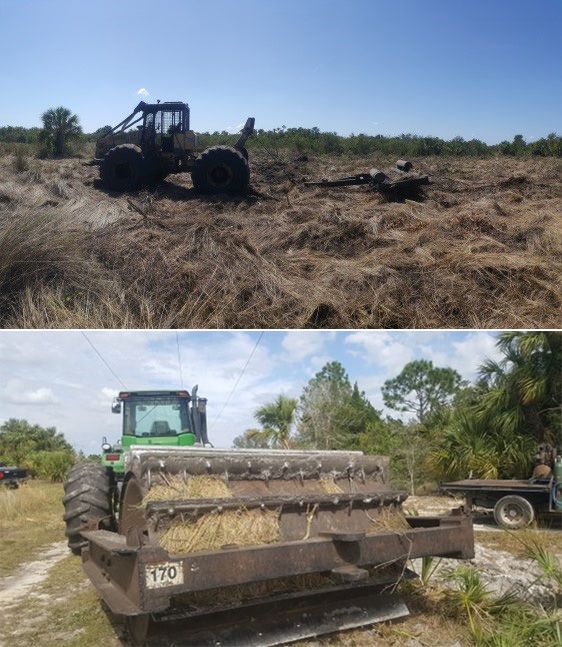
Credit: Top—Amy Copeland, St. Johns River Water Management District; Bottom—Graham Williams St. Johns River Water Management District. All photos used with permission.
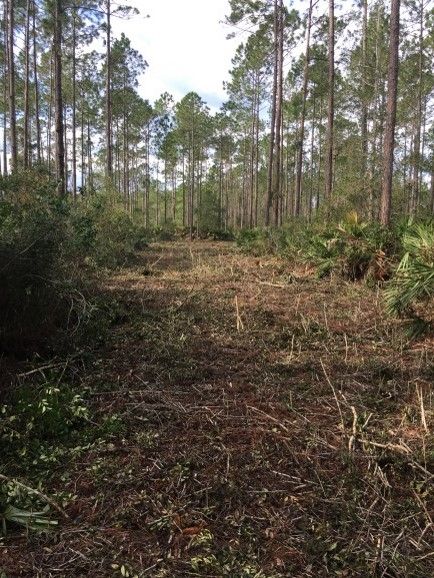
Credit: Christopher Kinslow, St. Johns River Water Management District
Mowing/Mulching
Mowing uses a rotary cutter head with heavy blades or disks that spin horizontally to the ground (e.g., a bush hog or Brown’s tree cutter). The disks/blades knock down and cut vegetation at the base of the plant. Mulching uses a drum rotating at high speed with cutter teeth aligned in rows to shred the vegetation (Figure 3).
Impacts and Tradeoffs of Mowing and Mulching Treatments
- Mowing is effective for herbaceous plants and small diameter (less than 3 inches) woody plants.
- Mulching is effective on woody plants up to 12-inch diameter.
- Small skid steer equipment (i.e., Bobcat) set up with mulching attachments can access difficult-to-reach and sensitive locations within a treatment area.
- Mowing and mulching production rates are slower than roller chopping rates.
- This method tends to be more costly per acre treated than roller chopping.
- Soil disturbance tends to be much lower with mowing and mulching than with roller chopping.
- When compared to prescribed fire in scrub ecosystems, the effects of mowing and mulching are not as long lasting and do not change overall fuel loads (Menges and Gordon 2010; Weekley 2011) despite having significant reduction in standing shrub density (Figure 4).
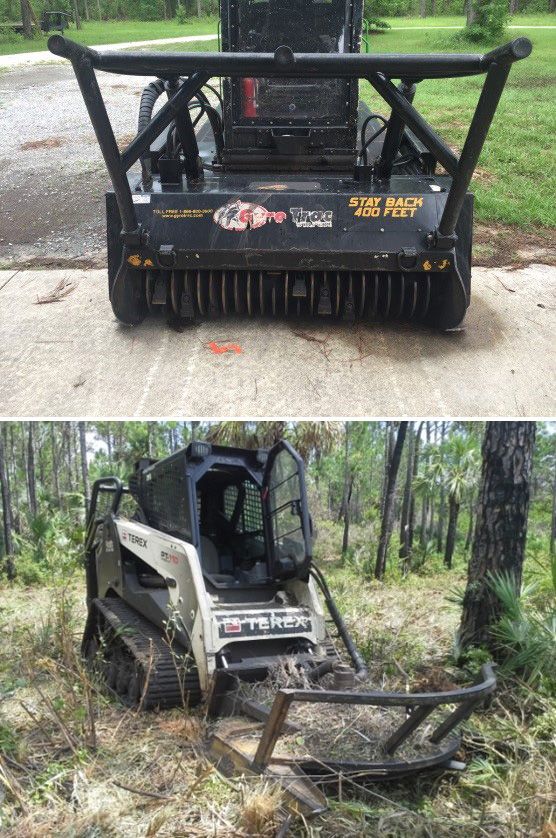
Credit: Top—Tyler Mosteller, St. Johns River Water Management District; Bottom—Graham Williams St. Johns River Water Management District

Credit: Christopher Kinslow, St. Johns River Water Management District
Timber Harvest
Timber harvest generally is not considered to be a fire surrogate but can accomplish many of the same objectives. Timber harvest is a common tool used to improve a stand as well as to reduce fuel loads. There are several types of timber harvests to consider (Figure 5):
Commercial thinning removes trees that are large enough to be sold. Commercial thinning an existing pine stands knocks down vegetation and removes a portion of it (the trunks of salable trees) with logging equipment. However, like chopping and mowing, commercial thinning does leave a portion of the biomass (e.g., small trees and the tops of the larger, salable trees) on the site.
Full-tree chipping operations are a viable option when aiming to reforest an overgrown site or remove a large amount of undesirable vegetation. Full-tree chipping operations, also called biomass harvests, take low-quality materials that might otherwise be too costly to harvest, chip them onsite, and haul them away. This is desirable because vegetation targeted for treatment is entirely removed from the site. It creates a site that is more aesthetically pleasing than one treated with herbicide, and one with greatly reduced fire and smoke management risks.
Silvicultural clearcut operations harvest all trees merchantable on a site. This method may or may not be lucrative depending on the size, species, and size of harvest. In some species, like sand pine (Pinus clausa), which generally only experience fire at high intensity, a clearcut harvest nearly mimics a stand-replacing fire (Greenberg et al. 1995).
Impacts and Tradeoffs of Timber Harvest Treatments
- In general, timber harvest in any form creates soil disturbance. With this disturbance comes bare mineral soil, which creates an opportunity for grasses to increase in abundance (Weekley et al. 2013). Timber harvest is a viable option for reducing shrub cover and increasing grass and groundcover species.
- Timber harvests can be a revenue producer or at least revenue neutral depending on size of the site, accessibility to markets, and stand conditions.
- Biomass harvests can cost as much as some of the other mechanical treatments, but few other operations will leave as little residual vegetation after treatment.
- Biomass harvests are not as available as conventional timber harvest due to limited markets for the product.
- Timber harvests may also be used as a first step to provide income towards other land-management activities.
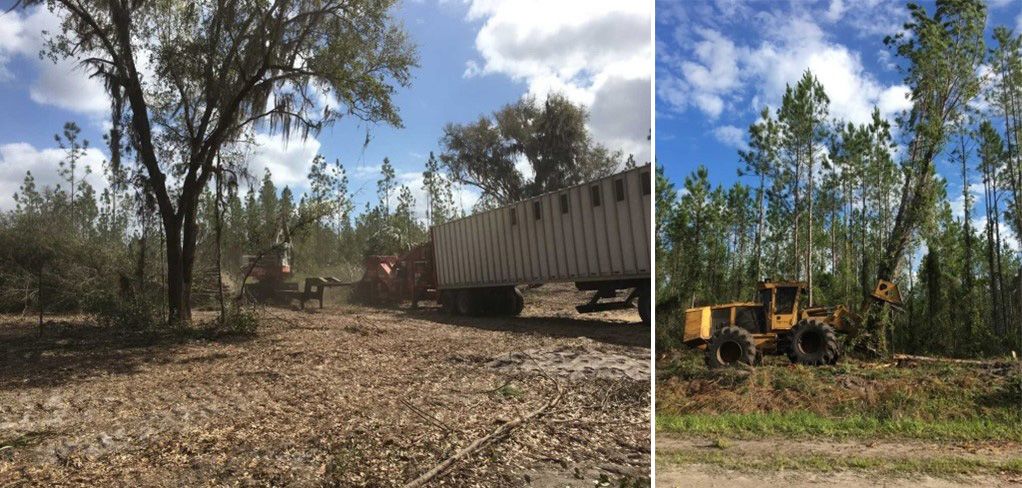
Credit: Christopher Kinslow, St. Johns River Water Management District
Hand-Felling Operations
Some areas are too ecologically sensitive, too remote, or too small for heavy equipment to operate, but this does not preclude them from a fire surrogate treatment using chainsaws or brush cutters. Wetlands or sandhills that have been encroached by undesirable tree species can be treated by felling or girdling undesirable species and retaining them on site (Figure 6). Felling ensures a set amount of top kill of the target species and immediately changes the sub-canopy of the area. Girdling also achieves a high level of control but leaves the dead tree in place, which can be useful to wildlife (e.g., insects/woodpeckers).
Impacts and Tradeoffs of Hand-Felling Operations
- Minimal ground disturbance.
- This method has the lowest production rate of all mechanical fire surrogates.
- The effects of this treatment on grasses and shrubs are somewhat limited.
- Studies of chainsaw operations suggest they are an excellent method to guide an area in the right direction with subsequent treatments using other methods (Menges and Gordon 2010).
- Hand felling may be the only feasible fire surrogate for sites with limited access.
- Unlike the methods previously described, hand felling does not greatly change the material structure of a site. Vegetation is not crushed, chipped or moved off-site; it it is merely rearranged.
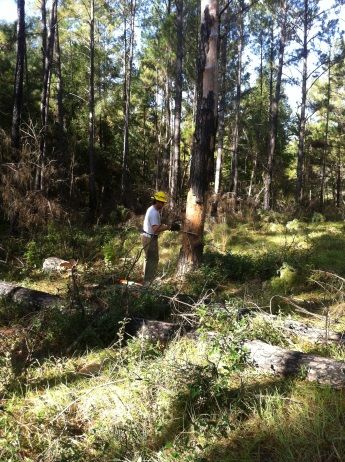
Credit: Andrew Rappe, The Nature Conservancy
Table 1. Comparison of Mechanical Treatments as Fire Surrogates.
Herbicide Treatments as Fire Surrogates
Since the 1950s, the use of herbicides to manage vegetation in natural systems has increased with the introduction of many new herbicides. Most herbicide applications on forest lands focus on site preparation prior to tree planting, controlling herbaceous weeds in young stands, reducing hardwood competition in established stands, managing invasive species, or restoration of desired habitats. Herbicides are used across all of Florida’s upland ecosystems for restoration and forest management and in many forested wetlands for invasive species management. The length of control provided by an herbicide is dependent upon its ability to suppress or kill the entire plant, including belowground portions that regenerate asexually, as well as its ability to suppress or kill new recruits from the seedbank. Efficacy of control can vary greatly among herbicides, but it is important to understand that a single herbicide application will rarely result in complete elimination of all living propagules of a target species. Therefore, herbicides should be viewed as a management tool that may need to be utilized multiple times and not as a silver bullet approach.
Herbicide options may vary by the sites labeled for use by the EPA and by the land manager’s goals. Herbicides may selectively control certain species or groups of species or be non-selective and control almost all species. To be effective, an herbicide must be applied in a manner that allows it to reach the intended target. There, it is absorbed through the leaves, stems, or roots, and translocated to the site of action, where it physiologically inhibits specific growth and development processes. To reach the intended target, herbicides may be broadcast applied for large-scale treatments or applied as spot treatments with spray bottles, backpacks, or handgun-type sprayers. Herbicide spot treatments with ground crews are generally more costly per acre than broadcast treatments. However, they can provide more surgical precision in terms of application and selective removal of target plants.
Some herbicides, such as glyphosate, are broad spectrum, or non-selective, in the plants controlled, whereas others, such as triclopyr, are selective, controlling certain plants while leaving others unaffected. Herbicide selectivity may also be a function of dose and application timing. For example, low rates of imazapyr broadcast over pine plantations can aid pine trees by controlling competing hardwoods and releasing the pines from competition, while high rates may injure longleaf and slash pines.
Many herbicides are available and labeled for various objectives. Here, we introduce two common herbicides to illustrate important concepts. The herbicides and methodology we describe are used specifically for hardwood trees, which are the greatest impediment to reintroducing fire on a landscape. In areas where fire may never be an option in the future, herbicide treatments can reinforce the control of fire-fueling species following a mechanical treatment. Herbicide treatments are an inexpensive method of fuel management, and costs can vary greatly depending on the herbicide selected and the method of application.
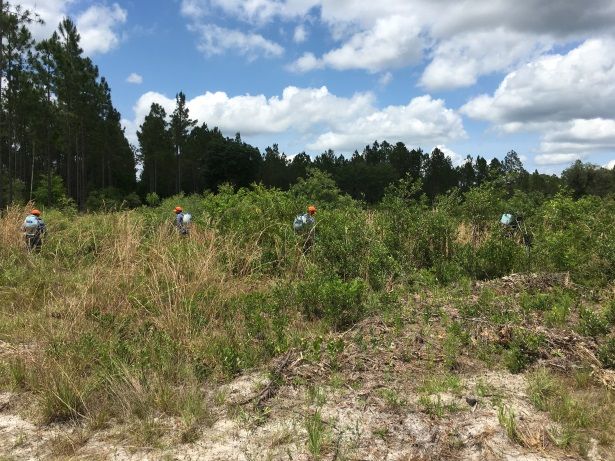
Credit: Kinslow, St. Johns River Water Management District
Hexazinone
Hexazinone is an herbicide commonly used on sandhills and drier sites for broad control of hardwood species (Figure 7). This herbicide is most effective in well-drained ecosystems; it is not recommended for flatwood ecosystems due to soil adsorption by organic matter. It is manufactured in pellet form under the trade name Pronone and in a liquid form under the trade name Velpar L, among others. Several studies (Brockway et al. 1998; Brockway et al. 2000; Provencher et al. 2001) have examined the effects of this herbicide and found it generally effective at controlling hardwoods.
Impacts and Tradeoffs of Hexazinone Applications
- Hexazinone is designed to be used on the soil trees grow in, not directly to the trees. It can be applied broadly or as a spot treatment around individual hardwood stems. Again, this herbicide is applied to the soil as opposed to the foliage or the bole of the tree.
- Both liquid and pellet forms of hexazinone are activated by moisture. There must be at least a quarter of an inch of rainfall within two weeks of application for the treatment to be effective. The herbicide must be applied during the growing season (late March to mid-August in Florida), optimal timing being just before or after leaf-out of the targeted hardwood species. If the herbicide is applied too early or too late, or if there is insufficient rainfall within two weeks of the treatment, the application will fail.
- This herbicide is very effective at hardwood control, but it is not selective. If you have trees you wish to preserve in a treatment site, perhaps mature trees or a particular species of hardwood, take care to exclude these trees by restricting your application of herbicide. Do not apply herbicide in the root zone of the desired trees (the area under their canopies). Keep hexazinone applications far enough away from trees you wish to keep that rain will not wash the herbicide into their root zones. Some hardwood species such as yellow poplar (Liriodendron tulipifera), blackgum (Nyssa sylvatica), and sassafras (Sassafras albidum), as well as shrubs such as American beautyberry (Callicarpa americana), are generally tolerant to hexazinone.
- Increases in grasses are often observed following hexazinone application. This can be attributed to general grass tolerance coupled with the removal of the mid-story canopy cover.
- The use of this herbicide close to property boundaries may also pose some risk. Since hexazinone is soil active, it can move though the soil beyond your boundary and cause damage to the trees of adjacent property owners.
- The pellet version is very easy to apply and requires no special equipment.
- For spot treatment, the liquid formulations are most effective when applied with metered application gun, such as the MeterJet Spray Gun by Gunjet.
- Hexazinone is moderately expensive compared to other herbicides. The liquid version is less expensive than the pellet type.
- The liquid form can be used for spot application or broadcast sprayed depending on objectives.
- Application rates will vary depending on soil type, objectives, and method of application.
- Hexazinone is not labeled for application where standing water is present.
Triclopyr
Triclopyr is a selective herbicide that controls broadleaf herbaceous and woody plants, including many hardwood trees and shrubs. There are four triclopyr formulations that can be applied with different techniques, depending on their water solubility. These include a water-soluble triethylamine salt formulation as well as an oil-soluble butoxyethyl ester formulation. Two more recent formulations include a water-soluble choline formulation and a free acid formulation that can be mixed with water or oil. Triclopyr can be applied using a variety of methods described below. Additional information on application methods can be found in the UF/IFAS publication SS-AGR-260, Herbicide Application Techniques for Woody Plant Control.
Foliar applications are broadcast applications using a backpack- or equipment-mounted sprayer. All four formulations can be used with this application method. Good coverage is required for complete control, and partial coverage generally will not be effective. Foliar treatments generally require a surfactant to improve absorption through the waxy cuticle on the leaf surface.
Basal bark treatments involve treating the lower stem or bole of the tree with the ester or free-acid formulations mixed in an oil carrier and using a backpack sprayer and spray wand. The lower 12 to 18 inches of the trunk is sprayed to wet with the herbicide/oil mix around the entire circumference of the tree. This technique is effective on trees and shrubs less than six inches diameter at breast height. The ester and acid formulations can be used for this application method.
Cut stump treatments involve treating the outer two inches of the surface around the circumference of a freshly cut stump with a water-soluble herbicide. All four formulations can be used with this technique. However, the ester formulation is most effective as a hybrid basal cut stump application, where the entire stump top and sides of the stump are treated.
Hack and squirt treatments involve creating an injury (i.e., a “hack”) to the bole of the tree into the conductive tissues just under the outer bark using a hatchet or machete and using a squirt bottle to apply 0.5 to 1.0 ml of concentrated herbicide into the hack. The number of hacks applied to the tree depends on its diameter and is specified in the herbicide label.
Impacts and Tradeoffs of Triclopyr Applications
- For areas with a dense, low (less than 6-foot) cover of hardwoods or shrubs like gallberry, a broadcast foliar application will reduce midstory cover in the short term (Freeman and Jose 2009). Managers who use handgun or backpack applications must take care not to overapply and damage non-targeted vegetation.
- For areas with moderate-to-dense cover of hardwood saplings and trees less than 6 inches in diameter, basal bark application is very useful. This can be tedious work, but in areas where desirable trees are nearby or the application area is near a neighbor, it will likely be the best option.
- For larger trees, generally those greater than 6 inches in diameter, use hack and squirt. Large trees can sustain the hack, and this method is preferable because it limits the overall amount of herbicide applied.
- Unlike hexazinone, triclopyr has limited soil activity except at very high concentrations; root exudation is not an issue with triclopyr.
- The ester formulation can volatilize at temperatures over 85°F and cause nontarget damage to surrounding susceptible plants, including many broadleaf agricultural crops. This is not an issue with the other formulations.
- Triclopyr is less costly than most herbicides.
- Triclopyr uses common herbicide application equipment.
- As with all herbicides, application rates for triclopyr will vary depending on objectives and method of application; consult the label before beginning any application.
- Be aware the requirements of the Florida Organo-Auxin Herbicide Rule to stay in compliance: SS-AGR-12/WG051: Florida's Organo-Auxin Herbicide Rule—2021 (https://edis.ifas.ufl.edu/publication/WG051)
Table 2. Comparison of Herbicides as Fire Surrogates.
Grazing Treatments as Fire Surrogates
Grazing is a cost-effective surrogate for prescribed fire. This method involves using ungulates, usually cows, the most common commercial grazing animal in Florida, but sometimes also goats and sheep, to feed on the forage of the landscape to reduce the amount of fuel available to burn.
Impacts and Tradeoffs of Grazing
- Grazing decreases both living and dead biomass but does not have a significant effect on surface litter (Porensky et al. 2018; Sonnier et al. 2020).
- Grazing can decrease the frequency and intensity of subsequent fires.
- For areas dominated exclusively by grasses, cattle are suitable grazers, and for areas with shrubs as well as grasses, mixed feeders (goats or sheep) are the best option.
- Allow a 1- to 2-year gap between grazing periods to increase forage quality and quantity. Through their excrement, grazing cattle deposit plant-available nitrogen into the soils. The 1- to 2-year gap in time allows the forage to take up the nitrogen and grow back stronger, providing more nutritional quality for cattle (Sonnier et al. 2020).
- Soil disturbance is moderate and often localized to watering sites, feed troughs, and cattle trails.
- Grazing can generate revenue for landowners. However, it requires infrastructure (e.g., fencing and water sources) that may be costly if not already in place.
- Poisonous plants can be an issue of concern and include species such as bracken fern, black cherry, perilla mint, showy crotalaria, and others.
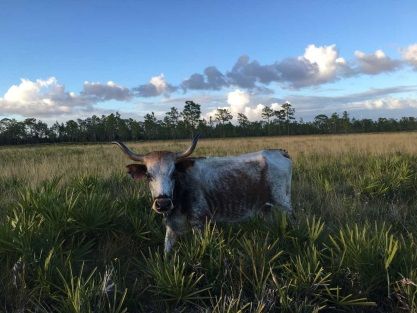
Credit: Jeremy Olson, St. Johns River Water Management District
Combining Surrogate Treatments with Fire
Finally, in some areas fire may be difficult to use but not completely off the table. In cases where surrogate treatments are used in conjunction with prescribed fire, the results can be quite effective (Menges and Gordon 2010; Schwilk et al. 2009). The combination of fire and herbicides can make up for decades of fire exclusion on a site, converting it to a state close to its former condition in less than 10 years (Outcalt and Brockway 2010). Mechanical treatments combined with fire can also speed restoration efforts (Watts et al. 2006), saving both time and money. Fire combined with grazing will decrease aboveground biomass as well as surface litter (Boughton et al. 2017).
Conclusion
In a land shaped by fire, nothing can fully replace its role in our ecosystems. But in areas that have been excluded from fire because fire is difficult to apply consistently or because the wildland-urban interface encroaches and renders fire impracticable, surrogates like machines, herbicides, and grazing are providing workable options.
Acknowledgements
Carolyn Hament, Marek Abrehamsen, and Lauren Watine contributed to this publication.
References
Boughton, E. H., P. J. Bohlen, and J. H. Maki. 2017. “Effects of Experimental Season of Prescribed Fire and Nutrient Addition on Structure and Function of Previously Grazed Grassland.” Journal of Plant Ecology 11 (4): 576–584. https://doi.org/10.1093/jpe/rtx022
Brockway, D. G., K. W. Outcalt, and R. N. Wilkins. 1998. “Restoring Longleaf Pine Wiregrass Ecosystems: Plant Cover, Diversity and Biomass following Low-Rate Hexazinone Application on Florida Sandhills.” Forest Ecology and Management 103 (2-3): 159–175. https://doi.org/10.1016/S0378-1127(97)00186-2
Brockway, D. G., and K. W. Outcalt. 2000. “Restoring Longleaf Pine Wiregrass Ecosystems: Hexazinone Application Enhances Effects of Prescribed Fire.” Forest Ecology and Management 137 (1): 121–138. https://doi.org/10.1016/S0378-1127(99)00321-7
Brown, S. K., and W. E. Palmer. 2022. “Effect of Prescribed Fire and Mechanical Treatments on Northern Bobwhite Occupancy in Mesic Pine Flatwoods.” National Quail Symposium Proceedings: Vol. 9, Article 61. https://doi.org/10.7290/nqsp09vNFj
Bultemeier, B., J. Ferrell, and G. MacDonald. 2021. “Florida’s Organo-auxin Herbicide Rule – 2021” SS-AGR-12/WG051, Rev. 12/2021”. EDIS 2021 (6) https://doi.org/10.32473/edis-wg051-2021
Fitzgerald, S. M., and G. W. Tanner. 1992. “Avian Community Response to Fire and Mechanical Shrub Control in South Florida.” Journal of Range Management 45 (4): 396–400. https://doi.org/10.2307/4003090
Freeman, J. E., and S. Jose. 2009. “The Role of Herbicide in Savanna Restoration: Effects of Shrub Reduction Treatments on the Understory and Overstory of a Longleaf Pine Flatwoods.” Forest Ecology and management 257 (3): 978–986. https://doi.org/10.1016/j.foreco.2008.10.041
Greenberg, C. H., D. G. Neary, L. D. Harris, and S. P. Linda. 1995. “Vegetation Recovery following High-Intensity Wildfire and Silvicultural Treatments in Sand Pine Scrub.” American Midland Naturalist 133 (1): 149–163. https://doi.org/10.2307/2426356
Menges, E. S., and D. R. Gordon. 2010. “Should mechanical treatments and herbicides be used as fire surrogates to manage Florida's uplands? A review.” Florida Scientist 73 (2): 147.
Moore, W. H. 1974. “Some Effects of Chopping Saw-Palmetto-Pineland Threeawn Range in South Florida.” Journal of Range Management 27 (2): 101–104. https://doi.org/10.2307/3896740
Outcalt, K. W., and D. G. Brockway. 2010. “Structure and Composition Changes following Restoration Treatments of Longleaf Pine Forests on the Gulf Coastal Plain of Alabama.” Forest Ecology and Management 259 (8): 1615–1623. https://doi.org/10.1016/j.foreco.2010.01.039
Provencher, L., B. J. Herring, D. R. Gordon, H. L. Rodgers, K. E. Galley, G. W. Tanner, J. L. Hardesty, and L. A. Brennan. 2001. “Effects of Hardwood Reduction Techniques on Longleaf Pine Sandhill Vegetation in Northwest Florida.” Restoration Ecology 9 (1): 13–27. https://doi.org/10.1046/j.1526-100x.2001.009001013.x
Porensky, L. M., B. L. Perryman, M. A. Williamson, M. D. Madsen, and E. A. Leger. 2018. “Combining Active Restoration and Targeted Grazing to Establish Native Plants and Reduce Fuel Loads in Invaded Ecosystems.” Ecology and Evolution 8 (24): 12533–12546. https://doi.org/10.1002/ece3.4642
Schwilk, D. W., J. E. Keeley, E. E. Knapp, J. McIver, J. D. Bailey, C. J. Fettig, C. E. Fiedler, et al. 2009. “The National Fire and Fire Surrogate Study: Effects of Fuel Reduction Methods on Forest Vegetation Structure and Fuels.” Ecological Applications 19 (2): 285–304. https://doi.org/10.1890/07-1747.1
Sonnier, G., P. F. Quintana‐Ascencio, P. J. Bohlen, J. E. Fauth, D. G. Jenkins, and E. H. Boughton. 2020. “Pasture Management, Grazing, and Fire Interact to Determine Wetland Provisioning in a Subtropical Agroecosystem.” Ecosphere 11 (8): 1–13. https://doi.org/10.1002/ecs2.3209
Sorensen, D. 1997. “Advantages and Effectiveness of Roller Chopping.” Proceedings: Ecology and Management of Pinyon-Juniper Communities Within the Interior West. USDA Forest Service, 15–18.
Tanner, G. W., J. M. Wood, R. S. Kalmbacher, and F. G. Martin. 1988. “Mechanical Shrub Control on Flatwoods Range in South Florida.” Journal of Range Management 41 (3): 245-248. https://doi.org/10.2307/3899177
Wade, D. D., J. D. Lunsford, M. J. Dixon, and H. E. Mobley. 1989. “A Guide for Prescribed Fire in Southern Forests.” Technical publication R8-TP-US Department of Agriculture, Forest Service, Southern Region (USA).
Watts, A., G. Tanner, and R. Dye. 2006. “Restoration of Dry Prairie Using Fire and Roller Chopping.” Land of Fire and Water: The Florida Dry Prairie Ecosystem 225–229.
Weekley, C. W., E. S. Menges, D. Berry-Greenlee, M. A. Rickey, G. L. Clarke, and S. A. Smith. 2011. “Burning More Effective Than Mowing in Restoring Florida Scrub.” Ecological Restoration 29 (4): 357–373. https://doi.org/10.3368/er.29.4.357
Weekley, C. W., E. S. Menges, A. L. Craddock, and R. Yahr. 2013. “Logging as a Pretreatment or Surrogate for Fire in Restoring Florida Scrub.” Castanea 78 (1): 15–27. https://doi.org/10.2179/12-030
Table 3. Comparison of Fire Surrogates.